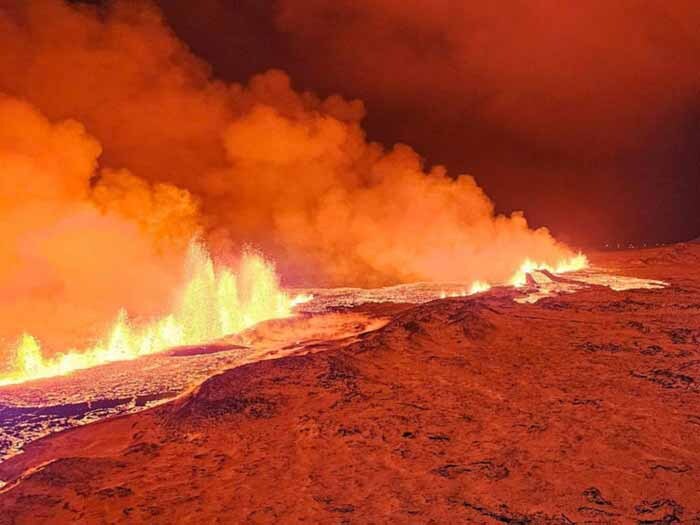
Posted by - News Staff![]() \
\
December 19, 2023 \
Filed in - Disasters \
Iceland Volcano eruption Reykjanes Grindavik \
2.7K views \ 0 reviews
Volcano eruption on the Reykjanes peninsula, about 3 km north of Grindavik, Iceland, following an earthquake on Dec. 18, 2023.
DLNews Mother Nature:
In a spellbinding display of nature's wrath, the long-awaited eruption cast its fiery spell upon Iceland's southwestern coast on Monday as the earth convulsed beneath the anticipation of tens of thousands of earthquakes. The volcanic extravaganza, now described as a "state of equilibrium" by scientists, unfolded in a captivating dance of earth and fire, leaving the world stunned by its explosive magnificence.
The Icelandic Meteorological Office sounded the alarm with an electrifying announcement: "An eruption has started north of Grindavík!" The drama unfolded as webcams captured the spectacle, revealing an otherworldly eruption dancing perilously close to Hagafell, a mere 3 km north of Grindavík.

The volcanic crescendo commenced amid an intense "earthquake swarm" around 9 p.m. local time, culminating in the eruption at 10:17 p.m. However, as the initial shockwaves subsided, officials reported a sudden decrease in intensity hours later, suggesting the volcanic colossus was entering a breathtaking "state of equilibrium."
President Guðni Th. Jóhannesson, the vigilant guardian, announced the closure of the affected area near Grindavík through the country's Civil Defense. With an air of suspense, he declared on social media, "We now wait to see what the forces of nature have in store. We are prepared and remain vigilant."

Flowing lava was seen during an eruption on the Reykjanes peninsula 3km north of Grindavik, western Iceland, on Dec. 18, 2023.
The eruption's fiery spectacle had a mesmerizing backstory. Iceland's Meteorological Office revealed that the volcanic drama unfolded on the "dyke intrusion that formed in November," with the eruption fissure sprawling southward, its southern extremity kissing Sundhnúkur.
As the night unfolded, Icelandic weather officials scheduled a rendezvous with scientists on Tuesday morning to dissect the enigmatic overnight events. The lava discharge, a mesmerizing torrent "hundreds of cubic meters per second," painted a vivid picture of nature's raw power. Picture this: molten rivers flowed laterally, creating an ever-expanding masterpiece as the earth seemed to breathe, exhaling plumes of red-hot majesty into the night.

This eruption, culminating in more than 20,000 seismic tremors since late October, was no stranger to anticipation. In a prophetic warning in November, local weather officials had foreseen a "significant likelihood" of a volcanic spectacle, leading to a state of emergency near the Mount Fagradalsfjall volcano on the Reykjanes Peninsula.
Recalling the situation's intensity, over 3,700 residents of Grindavík, a quaint fishing town, embarked on a daring evacuation on November 10, orchestrated by the Department of Civil Protection and Emergency Management. Minister of Foreign Affairs Bjarni Benediktsson hailed the operation as a success, showcasing Iceland's resilience in the face of nature's magnificent and unpredictable theatrics.
ICELAND'S VOLCANIC BALLET: LAVA UNLEASHED IN ... 0 0 0 630 4
4 photos

At Desert Local News, connections are everything. We're not just another social networking platform—we're a lively hub where people from all walks of life come together to share stories, spark ideas, and grow together. Here, creativity flourishes, communities grow stronger, and conversations spark global awareness.
Comments